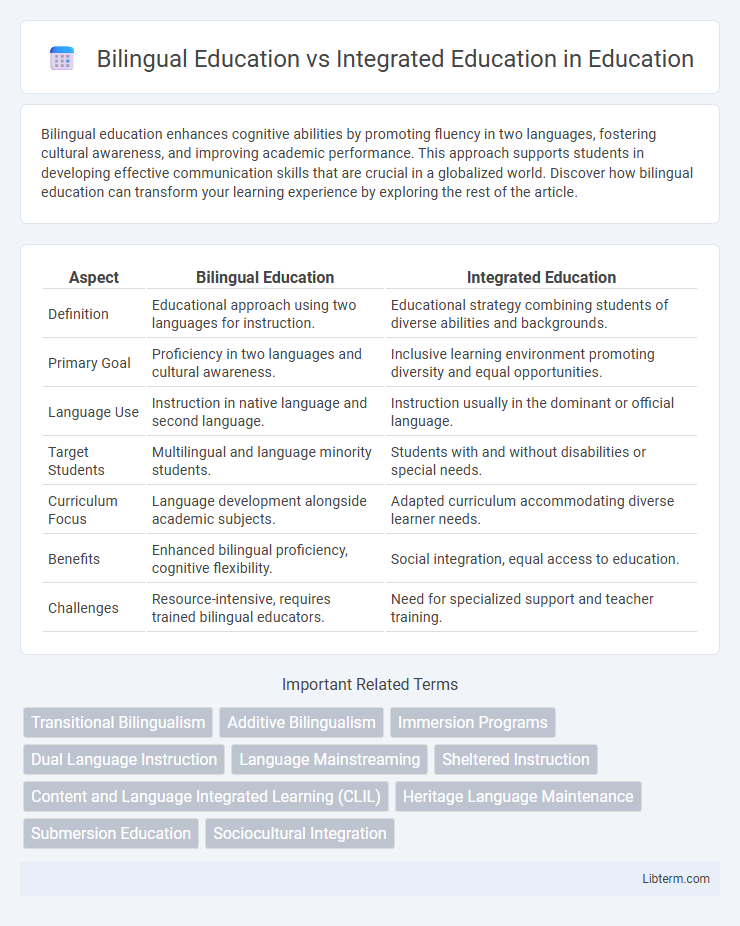Bilingual education enhances cognitive abilities by promoting fluency in two languages, fostering cultural awareness, and improving academic performance. This approach supports students in developing effective communication skills that are crucial in a globalized world. Discover how bilingual education can transform your learning experience by exploring the rest of the article.
Table of Comparison
| Aspect | Bilingual Education | Integrated Education |
|---|---|---|
| Definition | Educational approach using two languages for instruction. | Educational strategy combining students of diverse abilities and backgrounds. |
| Primary Goal | Proficiency in two languages and cultural awareness. | Inclusive learning environment promoting diversity and equal opportunities. |
| Language Use | Instruction in native language and second language. | Instruction usually in the dominant or official language. |
| Target Students | Multilingual and language minority students. | Students with and without disabilities or special needs. |
| Curriculum Focus | Language development alongside academic subjects. | Adapted curriculum accommodating diverse learner needs. |
| Benefits | Enhanced bilingual proficiency, cognitive flexibility. | Social integration, equal access to education. |
| Challenges | Resource-intensive, requires trained bilingual educators. | Need for specialized support and teacher training. |
Understanding Bilingual Education
Bilingual education involves teaching students in two languages, aiming to promote proficiency and literacy in both while supporting cognitive development and cultural awareness. It contrasts with integrated education, which typically combines students from diverse backgrounds without specifically focusing on dual-language instruction. Research highlights bilingual education's benefits in enhancing executive function, academic achievement, and maintaining students' native language skills alongside second language acquisition.
Defining Integrated Education
Integrated education refers to an inclusive approach where students with diverse backgrounds, abilities, and needs learn together in a single classroom environment. It emphasizes social cohesion and equal access to educational resources, blending academic instruction with social and emotional development. This model contrasts with bilingual education, which specifically targets language acquisition by teaching curriculum in two languages to support multilingual proficiency.
Key Differences Between Bilingual and Integrated Education
Bilingual education emphasizes teaching students in two distinct languages to promote fluency and cultural understanding, whereas integrated education merges students from diverse academic or social backgrounds into a unified learning environment. Bilingual programs often focus on language proficiency and cognitive benefits, while integrated education prioritizes social integration, equality, and reducing segregation. Key differences include instructional methods, language use, and educational goals tailored either toward linguistic competency or social inclusivity.
Benefits of Bilingual Education
Bilingual education enhances cognitive flexibility, improving problem-solving and multitasking skills by engaging both language centers of the brain. Students in bilingual programs demonstrate higher academic achievement and better cultural awareness, fostering greater empathy and communication abilities. Research shows that bilingual individuals enjoy long-term career advantages and increased opportunities in an interconnected global economy.
Advantages of Integrated Education
Integrated education fosters social cohesion by bringing students from diverse linguistic and cultural backgrounds together, enhancing mutual understanding and respect. It promotes equal access to quality education, reducing segregation and disparities associated with bilingual programs. This inclusive approach develops critical thinking and adaptability by exposing students to multiple perspectives within a unified learning environment.
Challenges Faced by Bilingual Programs
Bilingual education programs face significant challenges including limited access to qualified bilingual teachers and insufficient instructional materials tailored to diverse language pairs, which hinder effective language acquisition and content mastery. Students often struggle with balancing proficiency in both languages, leading to potential gaps in academic performance and social integration. Funding constraints and varying policy support across regions further complicate the consistent implementation and sustainability of bilingual education initiatives.
Limitations of Integrated Educational Models
Integrated educational models face limitations such as insufficient accommodation for students who require targeted language support, leading to potential gaps in bilingual proficiency development. These models often struggle with balancing content mastery and language acquisition, which can hinder academic achievement for learners with diverse linguistic backgrounds. Furthermore, integrated programs may lack specialized resources and trained educators adept at addressing the unique challenges of language learners compared to dedicated bilingual education systems.
Impact on Student Academic Performance
Bilingual education enhances cognitive flexibility and often leads to higher academic achievement by promoting proficiency in two languages, which supports better problem-solving and multitasking skills. Integrated education, blending students from diverse linguistic and cultural backgrounds, fosters social cohesion and exposure to multiple perspectives, indirectly benefiting academic performance through enriched critical thinking. Studies reveal bilingual learners frequently outperform peers in standardized tests of reading and math, while integrated settings contribute to improved collaboration and communication skills that support academic success.
Socio-Cultural Implications of Each Approach
Bilingual education fosters cultural preservation and identity reinforcement by promoting fluency in students' native languages alongside a second language, enhancing cross-cultural understanding and social inclusion within minority communities. Integrated education emphasizes social cohesion and equal opportunity by bringing diverse linguistic and cultural groups together in a unified learning environment, which can reduce prejudice and foster a shared societal identity. Both approaches carry significant socio-cultural implications, with bilingual education supporting cultural diversity and heritage maintenance, while integrated education promotes multicultural interaction and social integration.
Choosing the Right Educational Model for Diverse Learners
Bilingual education supports diverse learners by fostering proficiency in two languages, enhancing cognitive flexibility and cultural awareness, which is particularly beneficial in multilingual communities. Integrated education combines students from various backgrounds into a single classroom, promoting social integration and inclusivity while addressing academic disparities through differentiated instruction. Selecting the right educational model depends on factors such as community language needs, available resources, and the specific linguistic and cultural profile of the student population.
Bilingual Education Infographic

 libterm.com
libterm.com